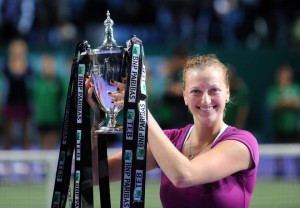With the WTA Championships settled in Petra Kvitova’s favor on Sunday afternoon, tour CEO Stacey Allaster delivered a comprehensive end-of-the-season message that made women’s tennis sound as exciting as the Super Bowl, the NBA Finals and the seventh game of the World Series all wrapped up in one thrilling package.
And going over Stacey’s checklist of WTA accomplishments, there is indeed a lot that looks good on paper about the women’s game right now.
So why am I sitting here feeling pretty pessimistic about where the WTA is headed in the next few years?

You can start with the perplexing No. 1 status of Caroline Wozniacki, who for the second year in a row finishes the year as the top-ranked player, but who is yet to win a Grand Slam title.
That’s not Caroline’s fault, of course. She didn’t create the ranking system. Her job is to go on court and perform, which she does with enough consistency in everything but the Slams to reach No. 1 and stay there for two years in a row.
How could she be No. 1 for so long? Begin with the litany of injuries to Serena Williams, who should be No. 1. Next, understand that Kim Clijsters has played one match since June 16, retiring with a recurring injury at Toronto. She could have been No. 1. Now add in a lineup of top 10s who play great one week, then not nearly so great the next. What you’re left with is Wozniacki, almost by default.
Along with seven other top players, Caroline was in Istanbul this past week for the WTA Championships, and it was hardly shocking that she lost two of her three round-robin matches and failed to advance to the semifinals. It was the first time since the WTA went to a round-robin format in 2003 that the No. 1 player couldn’t get out of the round-robin phase.
What the WTA right now is lacking is that one player everyone shoots at. On the men’s side, it was Roger Federer for a few years, then Rafa Nadal, and now Novak Djokovic — all of them Grand Slam tournament winners.
But Wozniacki, despite her considerable talent, is not yet that player and, in fact, until someone steps forward with remarkable consistency, I think it’s reasonable to assume that there is only one player capable of being that focal-point player, and that’s Serena Williams.
The problem, as we all know, is that Williams’ future in tennis continues to be a mystery. She played only six tournaments this year because of injury and, though there has been no definitive explanation for her latest absence from the game, she hasn’t been on court since she was shockingly beaten in straight sets by Sam Stosur in the U.S. Open final.
One can only assume that after sweeping through six opponents in New York, Williams’ foot was reinjured. Who knows if she’ll be back in 2012. And who can say if she does return in 2012 how long it will be before she’s injured again.
No matter what you feel about Williams’ anger management problems, when she is fit and playing she gives women’s tennis more focus by far than any of her competitors. She is the one player who electrifies the women’s game.
When she’s not on court, the women’s game becomes much more of a crap shoot at the major tournaments, and there is something positive to be said about having four different Slam winners this year (Clijsters, Li Na, Kvitova and Stosur), but where are those charismatic players who expand the women’s tennis audience?
There is no overlooking what Allaster has accomplished since she was ascended to the tour’s No. 1 executive job, and she richly deserved the new contract she signed last week. Perhaps at the top of her personal list of accomplishments was shortening the season to 10 months (less than 10 for those players who don’t qualify for the WTA Championships).
“When we look at the athletes’ performance, it all comes down to this circuit structure, where we took five years to modify it after we knew we were burning out the athletes,” she told a roomful of Turkish media.
“The season was too long, and we ultimately couldn’t deliver it to fans and to sponsors. So in 2009, we launched our new circuit structure, the most comprehensive set of reforms in the history of the WTA. And the shortened season, this streamlined calendar, with more breaks with geographical flow around the Slams is working. Our top player participation is up 24 percent at our premier events. Our injuries are down 18 percent.”
Allaster went on to announce that attendance was up 12 percent in 2011 “at our premier events. We have more jobs. We had four new tournaments in 2011, and prize money next year will increase 8 percent. That’s kind of the ultimate litmus test.”
If attendance is up 12 percent, I’m happy for the WTA, though I’m not sure if she’s counting overall attendance at combined events like Indian Wells and Key Biscayne, where the men have had a big part in increasing attendance.
All I know is that at this point there is no dominant woman player, aside from the chronically injured Williams, and while I understand that it is inspiring for the women in the top 10 who really feel they have a chance at a big title with Serena out of the majors, I’m not sure the public right now wants to hang its hats on names like Kvitova or Azarenka.
Maybe a year from now Kvitova will be on the sort of streak that Djokovic has fashioned in 2011. If so, she can become a legitimate focal point for the game.
But with Clijsters retiring and Williams a continual question mark, I’m thinking Allaster has a very hard sell in 2012 to keep women’s tennis at the high level that it deserves.
